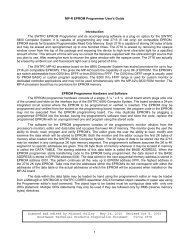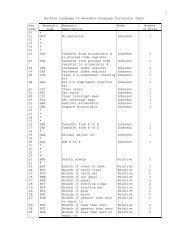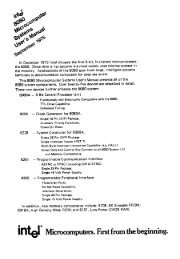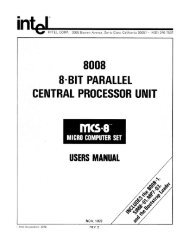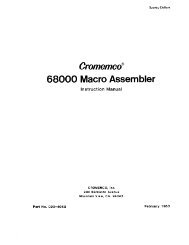The System Manual of SOL-20 - History of Computers
The System Manual of SOL-20 - History of Computers
The System Manual of SOL-20 - History of Computers
You also want an ePaper? Increase the reach of your titles
YUMPU automatically turns print PDFs into web optimized ePapers that Google loves.
PROCESSOR TECHNOLOGY CORPORATION<br />
Sol THEORY OF OPERATION<br />
SECTION VIII<br />
This detector circuit consists <strong>of</strong> three transistors, Q7, Q8,<br />
and Q9 (connected as a linear amplifier with negative feedback) followed<br />
by Q4 and Q2. Q4 and Q2 are large signal amplifiers biased in<br />
their cut-<strong>of</strong>f region. <strong>The</strong> input to the detector is selectively connected<br />
to +5 V dc by way <strong>of</strong> the analog multiplexers (Ul9 and U22),<br />
the row matrix wires, and the 33K resistors. A key depression causes<br />
a negative current pulse through R16 to the base <strong>of</strong> the input amplifier<br />
transistor, Q8, which is biased near cut-<strong>of</strong>f. <strong>The</strong> pulse is then<br />
amplified by Q8 with inversion to appear as a positive pulse at the<br />
input <strong>of</strong> Q7. Q7 is an emitter follower circuit which gives a positive<br />
pulse at its output, across R18, at a low impedance. This signal<br />
is coupled back to the input through transistor Q9, a common<br />
base amplifier which has its base clamped to 2.5 V dc by zener diode<br />
CR4. When the positive pulse appears at the emitter <strong>of</strong> Q9, it is<br />
amplified without inversion and applied to the input <strong>of</strong> Q8. Since<br />
the original input was a negative pulse, the positive pulse constitutes<br />
negative feedback. <strong>The</strong> output across R18, a positive pulse,<br />
is further amplified by pulse amplifier transistor Q4, a common base<br />
amplifier that is normally biased <strong>of</strong>f. <strong>The</strong> output stage Q2 is biased<br />
in the cut-<strong>of</strong>f region also, but a sufficient positive pulse<br />
from Q4 will cause Q2 to conduct to give a negative pulse output<br />
across R12.<br />
Transistors Q1, Q6, Q5 and Q3, represent a second pulse amplifier<br />
circuit that is analogous to transistors Q9, Q8, Q7 and Q4<br />
respectively. <strong>The</strong> output <strong>of</strong> this second amplifier, which appears at<br />
the collector <strong>of</strong> Q3, is also connected to the base <strong>of</strong> the output<br />
transistor Q2. An input pulse from either Ul9 or U22 will therefore<br />
supply an amplified negative pulse to pin 13 <strong>of</strong> NOR gate U14.<br />
<strong>The</strong> !PKD signal through R24 helps to set the threshold at the<br />
base <strong>of</strong> Q4 and Q3. This threshold is normally high when !PKD is high,<br />
so the output from Q7 and Q5 has to overcome a higher threshold at<br />
the emitter <strong>of</strong> Q4 and Q3 in order to cause conduction <strong>of</strong> Q4 and Q3.<br />
On the second such pulse on the same count address, !PKD goes low to<br />
reduce the threshold at the bases <strong>of</strong> Q4 and Q3. This sensitizes the<br />
circuit, acting as a positive feedback path, and gives an output.<br />
Thus two consecutive detections <strong>of</strong> a key stroke are necessary to give<br />
an output. This feature provides noise immunity since a single noise<br />
pulse will not pass through the amplifier. <strong>The</strong> complete key switch<br />
matrix is scanned at a very high rate compared to the time it takes<br />
to physically press and release a key. Thus a key closure will be<br />
detected, even though the key is not held down for any appreciable<br />
time.<br />
Two sections <strong>of</strong> NOR gate Ui4 are connected as a cross-coupled<br />
flip-flop. A low on pin 13 <strong>of</strong> Ui4 sets output pin 11 <strong>of</strong> U14 high,<br />
providing that the low is longer than 1.5 usec (which it is when a<br />
valid key closure is detected). That is because !φ1 is applied to pin<br />
9 <strong>of</strong> U14. !φ1 effectively prevents switching noise, which is short in<br />
duration, from being interpreted as a key closure. <strong>The</strong> high, let's<br />
call it KEY, on pin 11 <strong>of</strong> U14 will remain until !φ1 again goes low<br />
about 4.5 usec later.<br />
VIII-41



